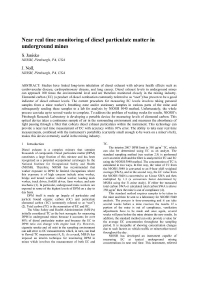 |
Studies have linked long-term inhalation of diesel exhaust with adverse health effects such as cardiovascular disease, cardiopulmonary disease, and lung cancer. Diesel exhaust levels in underground mines can approach 100 times the environmental level and are therefore monitored closely in the mining industry. Elemental carbon (EC) (a product of diesel combustion commonly referred to as "soot") has proven to be a good indicator of diesel exhaust levels. The current procedure for measuring EC levels involves taking personal samples from a mine workers breathing zone and/or stationary samples in various parts of the mine and subsequently sending these samples to a lab for analysis by NIOSH 5040 method. Unfortunately, the whole process can take up to several weeks to complete. To address the problem of waiting weeks for results, NIOSH Pittsburgh Research Laboratory is developing a portable device for measuring levels of elemental carbon. This optical device takes a continuous sample of air in the surrounding environment and measures the absorbance of light passing through a filter that collects diesel exhaust particulates within the instrument. This technology can provide a near real time measurement of EC with accuracy within 10% error. The ability to take near real time measurements, combined with the instrument's portability (currently small enough to be worn on the belt of a miner), makes this device extremely useful in the mining industry.
| Author(s): | Janisko-SJ, Noll-JD |
| Reference: | Proceedings of the 12th U.S./North American Mine Ventilation Symposium, Reno, Nevada, June 9-11, 2008. Wallace, Jr. KG. ed., Reno, NV: University of Nevada - Reno, 2008; :509-513 |
nrtmo (PDF, 116 KB)